In an era dominated by technology and digital advancements, the term “digital literacy” has become more than just a buzzword; it’s a crucial skill set that shapes the educational landscape. Digital literacy is not merely the ability to use digital tools; it encompasses a range of skills and competencies that empower individuals to navigate, critically evaluate, and contribute meaningfully to the digital world.
Understanding Digital Literacy: Beyond Basic Skills
Digital literacy transcends basic computer skills. It involves a multifaceted set of abilities that enable individuals to engage with digital information, media, and technology in a meaningful way. The components of digital literacy can be broadly categorized into several key areas:
Basic Digital Skills:
Technical Proficiency: The foundational skills include operating digital devices, navigating software, and using essential tools like word processors and spreadsheets.
Information Literacy:
Evaluating Information: Digital literacy entails the ability to critically evaluate online information, distinguishing between credible sources and misinformation.
Research Skills: Students need to be adept at conducting online research, synthesizing information, and citing sources.
Media Literacy:
Analyzing Media Content: Understanding how to analyze and interpret various forms of digital media, including images, videos, and audio, is essential.
Digital Communication: Proficiency in using digital communication tools, such as email, messaging apps, and social media, is part of media literacy.
Critical Thinking:
Problem-Solving: Digital literacy encourages the development of problem-solving skills in the digital realm, fostering the ability to overcome challenges and troubleshoot issues.
Critical Evaluation: Students learn to critically assess the validity and reliability of digital content and the implications of their online actions.
Cybersecurity Awareness:
Online Safety: Understanding the importance of online safety, including protecting personal information, recognizing phishing attempts, and practicing secure online behaviors.
Awareness of Cyber Threats: Knowledge about common cyber threats, such as malware and phishing, and strategies to mitigate these risks.
Why Digital Literacy Matters in Education:
- Preparation for the Digital Workforce: In a rapidly evolving job market, digital literacy is a prerequisite for many professions. Teaching students digital skills prepares them for the demands of the modern workforce, where technology is ubiquitous.
- Global Connectivity: Digital literacy facilitates global connectivity. Students can collaborate with peers worldwide, access diverse perspectives, and engage in cross-cultural exchanges through digital platforms.
- Critical Thinking and Problem-Solving: The ability to think critically and solve problems in the digital realm is vital for success in academic and professional settings. Digital literacy encourages students to approach challenges analytically and creatively.
- Empowering Independent Learners: Digital literacy empowers students to be independent learners. They can access a wealth of information online, engage in self-directed research, and take ownership of their educational journey.
- Combating Misinformation: In an era of information overload, the ability to discern accurate information from misinformation is crucial. Digital literacy equips students with the skills to navigate the vast online landscape responsibly.
- Enhancing Creativity and Innovation: Digital literacy fosters creativity by providing tools for digital creation, multimedia projects, and innovative solutions. Students can express themselves in new and dynamic ways.
- Digital Citizenship: Understanding ethical behavior, online etiquette, and responsible digital citizenship is an integral part of digital literacy. Students learn to engage respectfully and responsibly in digital communities.
Integrating Digital Literacy into Education: Strategies and Approaches
- Incorporate Digital Literacy in Curricula: Embed digital literacy into the curriculum across subjects and grade levels. Integrate digital skills seamlessly into lessons, projects, and assessments.
- Professional Development for Educators: Provide ongoing professional development for educators to enhance their own digital literacy skills. This ensures that teachers can effectively guide students in navigating the digital landscape.
- Hands-On Learning and Exploration: Foster hands-on learning experiences that allow students to explore digital tools and technologies. Project-based learning, coding exercises, and multimedia projects can enhance digital literacy.
- Promote Critical Discussion: Encourage critical discussions about online content, digital ethics, and responsible online behavior. Create a safe space for students to express opinions, ask questions, and learn from one another.
- Collaborative Learning: Emphasize collaborative learning through digital platforms. Encourage students to work together on projects, share insights, and engage in online discussions, fostering a sense of digital community.
- Real-World Applications: Connect digital literacy skills to real-world applications. Show students how the skills they are developing are relevant to their current lives and future careers.
Challenges and Future Considerations:
While digital literacy is integral to education, challenges exist. Some students may lack access to digital devices or high-speed internet, creating disparities. Addressing these issues requires a concerted effort to bridge the digital divide and ensure equitable access to technology.
Looking ahead, the evolution of technology will continue to shape the landscape of digital literacy. Emerging technologies such as artificial intelligence, augmented reality, and virtual reality will introduce new dimensions to digital literacy education, requiring educators to adapt and stay current.
Digital literacy is more than a set of skills; it’s a gateway to empowerment in the digital age. As education adapts to the demands of a technology-driven world, fostering digital literacy becomes a mission critical for preparing students for success. In doing so, we equip students not only with the tools of the present but also with the resilience and adaptability needed for the challenges and opportunities of the future.

